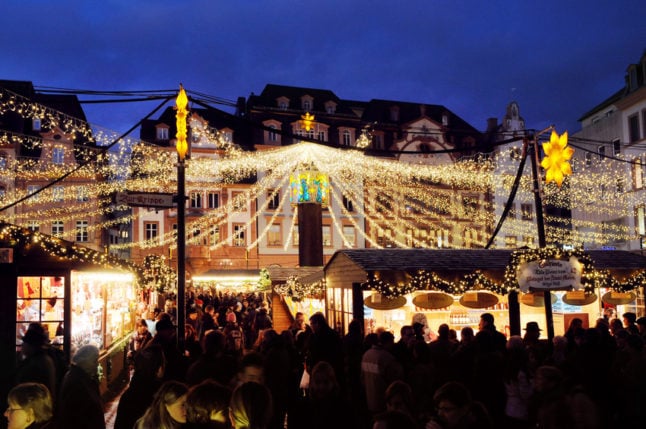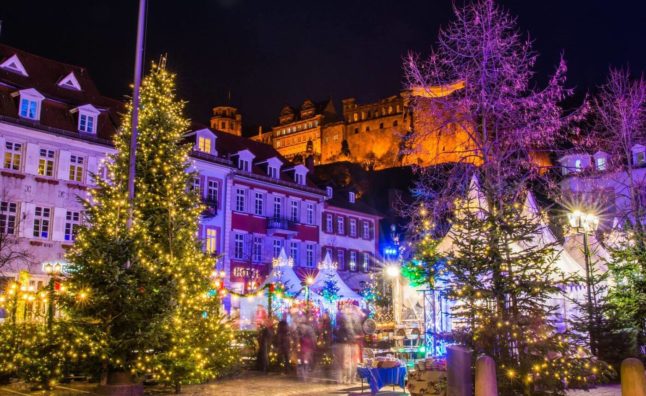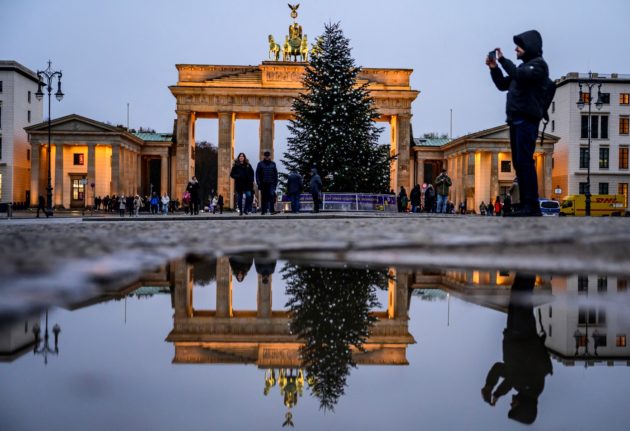Here’s when you can experience some of the best that Baden-Württemberg and Rheinland-Palatinate offer.
Baden-Württemberg
Stuttgart & Surroundings
The state capital’s Christmas market has been running for around three hundred years, with roots that go back even further. Stuttgart’s Christmas market is also among the most popular in Germany – an estimated three and a half million visitors attend each year! The market takes up much of the city’s heart, and hundreds of stalls offer food, drink and gorgeous Christmas decorations. Tip: Take a trip on the giant Ferris wheel in front of the Neue Schloss! This year’s market runs each day from November 29th to December 23rd.
Ludwigsburg, Stuttgart’s stately cousin just to the north, will also showcase its gorgeous 18th-century architecture and local delicacies in its annual ‘Baroque Christmas Market‘, running in the city’s Marktplatz between November 23rd to December 22nd (closed November 26th for a local holiday).
Mediaeval jewel Esslingen, twenty minutes by train from Stuttgart’s city centre, also features Christmas markets worth your while. Not only is there a range of stalls offering modern gifts and decorations at the ‘Christmas Market’, but the ‘Medieval Market’ next door is truly something to behold, with food, gifts and performances straight out of the 15th century, when the Imperial Free City was at its peak. Both take place every day from November 23rd to December 21st.

Freiburg
While the Christmas market in the mediaeval university city of Freiburg im Breisgau is a modern addition (first occurring in the 1970s), that’s not to say it’s not a spectacular experience. While Freiburg’s Christmas market winds through the city’s historic centre, most stalls can be found on the scenic Rathausplatz. Tip: If you’re taking the kids, they can help make some of the Black Forest region’s tastiest creations in the ‘Children’s Bakery’. The market is open between November 23rd and December 23rd (Closed November 26th).
Typical of the relative authenticity of the Freiburg Christmas market is you get quite informal choirs popping up, either just pairs of kids or full groups. Lovely pic.twitter.com/T2VVzYiJd0
— Reggie Tricker (@reggietricker) December 17, 2018
Heidelberg
For a truly spectacular location for a Christmas market, you can’t miss Heidelberg. Nestled in the valley created by the Neckar River, the city has hosted a famed university and has been a local centre of power for centuries. The majestic and romantic ruins of Schloss Heidelberg can be seen from many of the squares in the city’s heart, where the Christmas market occurs.
Tip: If there’s one market where you can take memorable photos, this is it – the floodlit castle is astonishing. The Heidelberg Christmas market takes place between November 27th and December 22nd.
So this is Heidelberg and the Christmas market we are heading to tomorrow??? Looks like I will love the place 😀 pic.twitter.com/J3WKXtp7jL
— Denise Weber ♜ ♫ (@Denise230468) December 9, 2016
Mannheim
Mannheim’s an 18th-century creation, laid out (famously) in a very modern grid – but that doesn’t mean the city’s Christmas market isn’t a magical experience. The city’s Christmas market is focused around the iconic ‘Wasserturm’ and is one of the country’s largest. While it’s not as famous as others in the region, that makes it even better – you can focus on the beautiful variety of food (one of the market’s specialities) without having to elbow your way (too much) through crowds. The market runs from November 27th to December 22nd.
Lovely evening at the Mannheim Christmas market. pic.twitter.com/Y3n1Mbg3UX
— Mezzanine (@Mezzanine71) December 2, 2019
Konstanz
The most beautiful city on the Bodensee has a Christmas market to match. While it’s only been running in its current form since 1989, it’s become one of the most beloved in the region. One reason is the presence of one of the lake’s White Fleet passenger ships, where visitors can retire for a hot drink and spectacular views, moored right next to the market. It runs from November 30th to December 23rd.
Visiting Konstanz, at Lake Constance. First Christmas market of the year, with excellent amounts of mulled wine and snacks 😍 pic.twitter.com/Lq4U6CW3P2
— A Year in Tri 👩💻🏃🏻♀️🛸 (@AYearInTri) November 26, 2022
Ulm
Ulm was one of Germany’s wealthiest cities during the Middle Ages, so it’s only fitting that the city boasts a Christmas market. Hundreds of stalls offer great food and beautiful handcrafted decorations in the city’s Munsterplatz, dominated by the world’s tallest church spire.
Tip: Time your visit during daylight hours to get incredible views from the top of the Ulm Munster’s spire. Ulm’s Christmas market extends from November 27th to December 23rd.
Christmas Market in Ulm pic.twitter.com/rBpyD2zv8H
— Cinder (@Ironic_Furry) November 27, 2021
Rheinland-Palatinate
Mainz
The home of the printing press also leaves a great impression through its Christmas market. Many Christmas markets like to think they’re among Germany’s most beautiful, but Mainz, the state capital, has a strong claim, with its offerings filling the square around the city’s millennium-old cathedral, the Mainzer Dom. Tip: With the historical background of the cathedral, renaissance buildings and a focus on exquisite lighting, this is another Christmas market for photography lovers. The Christmas market runs between November 30th and December 23rd.

Kaiserslautern
Despite its modern appearance, Kaiserslautern has a long and storied history, which is reflected in the Christmas market outside the centuries-old Stiftskirche and the 19th-century Fruchthalle. If you’re one for Christmas carols, there’s a comprehensive program of musical performances here that comes highly recommended. Kaiserslautern’s Christmas market takes place between November 20th and December 23rd.
Kaiserslautern's Christmas Market promises to be an unforgettable event for the whole family https://t.co/4U3eUmMuYw pic.twitter.com/yb3M5ZjEUo
— Military in Germany (@MILinGermany) November 20, 2017
READ MORE: An essential guide to Bavaria’s Christmas markets this winter
Speyer
Speyer is one of Germany’s oldest cities, a seat for former kings, and, indeed, is the resting place for many of them. The city’s cathedral, the Speyerer Dom, is the perfect backdrop for the local Christmas market, which spills along the Maximilianstrasse that leads towards it. Tip: Speyer’s Christmas market has a packed schedule of events and performances, so it’s a good idea to check the website for what’s available on the day you plan to visit. You can experience Speyer’s Christmas market from November 27th to January 7th.
#Germany #Christmas #Viatorius
Beautiful Christmas market at #Speyerhttp://t.co/ztZW6R933g pic.twitter.com/8GvxcVVuFt— markus germann (@German_guide) March 16, 2014
Trier
Another of Germany’s oldest cities, Trier, offers intense competition to its neighbours in Mainz, Worms, and Speyer regarding its festive offerings. Trier’s Christmas market takes place outside its cathedral, the Trierer Dom, and incorporates a robust mediaeval feel. Tip: It’s also where to head if you’ve got a sweet tooth, with the local Gebäckkringel, Dampfnudeln and Marzipanstollen enjoying a reputation far beyond the state’s borders. Trier’s Christmas market takes place between November 24th and December 22nd.
Visit Rhineland-Palatinate for some of the most unique & authentic https://t.co/4xz1PgqpvC in Europe! Enjoy Trier, the oldest city in Germany or Bernkastel-Kues medieval old town Christmas market, while Traben-Trarbach has an underground Xmas market which is a "one-of-a-kind". pic.twitter.com/IU8tTBdtqa
— Visit Germany (@VisitGermanyUK) October 14, 2019
Worms
Worms is a significant city in German music, performance, myth, and legend – where the famous Nibelungenlied was thought to have been written in the Middle Ages. So it’s appropriate that at the city’s Christmas market, which takes place throughout the ancient centre, you’ll find many stages where musicians, poets and other performers entertain visitors. Naturally, the food and handcrafted offerings are also fantastic. Experience Worm’s market from November 27th to December 23rd.
Impressions from the 2017 #Nibelungen Christmas Market in #Worms. More pictures at https://t.co/o8SUDMwJul pic.twitter.com/ckvLJigDQk
— Michael Debets (@MichaelDebets) December 23, 2017
Are you aware of an unmissable Christmas market in Baden-Wurttemberg or Rheinland-Pfalz? Let us know!



 Please whitelist us to continue reading.
Please whitelist us to continue reading.
Member comments